Wed, December 13, 2023
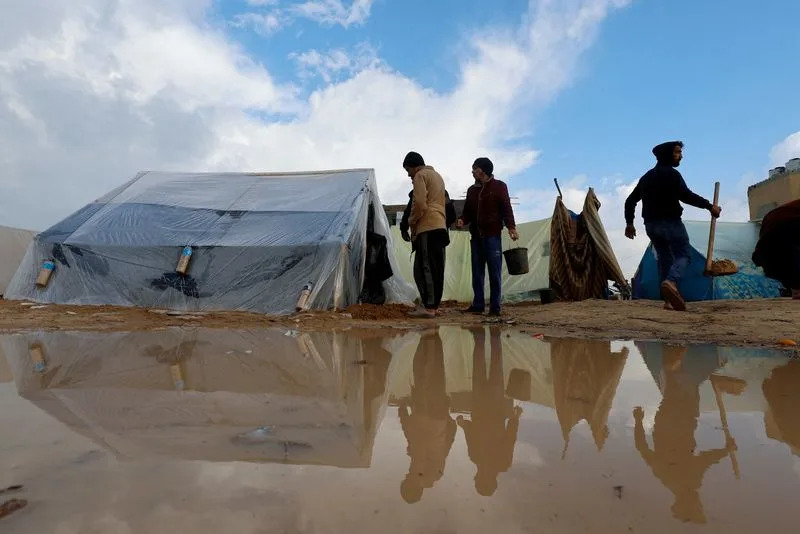
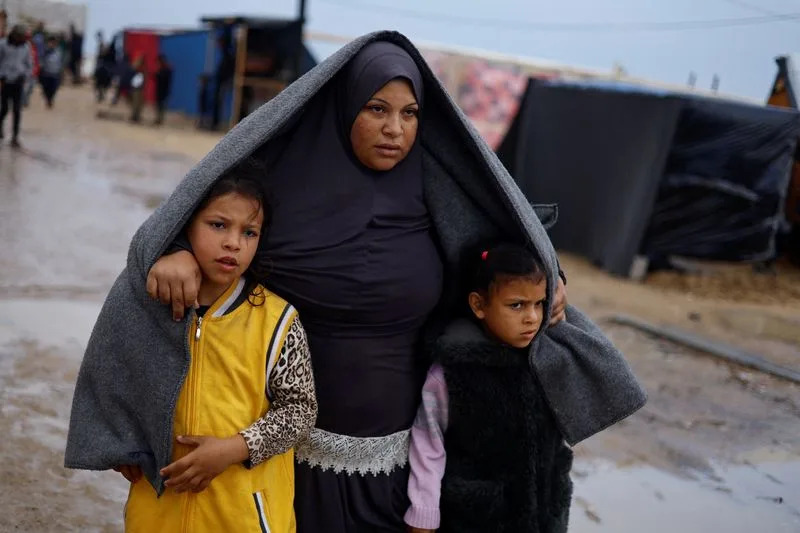
Aftermath of Israeli strikes on houses in Rafah
By Mohammed Salem and Saleh Salem
RAFAH, Gaza Strip (Reuters) - Strong wind and heavy rain in Gaza overnight on Wednesday brought even worse misery to displaced families, tearing and flooding flimsy tents, drenching clothes and blankets and making everyone cold.
At a tent camp in Rafah, located on sandy terrain strewn with rubbish, people were trying to recover from a horrible night, carrying buckets of sand to cover puddles inside or just outside their tents, and hanging up soggy clothes.
Some families have proper tents, but others are making do with tarpaulins or thin, see-through plastic made to protect goods, not provide shelter for people. Many tents have no ground-sheets, so people spent the night huddling on wet sand.
"It is torn and water poured on us. We were drenched," said Ramadan Mohadad, a middle-aged man who was trying to fix his family's shelter fashioned from strips of plywood and a thin plastic sheet.
Mohadad's white t-shirt with stripes had large wet patches around the collar and on both shoulders.
"We tried as much as we could to protect ourselves so water would not get through but rain got in ... This plastic does not protect people sleeping under it," he said.
Rips were visible in other families' plastic shelters, and some showed puddles inside. One family had placed a cement block at the entrance to act as a sort of dam, as well as smaller bricks inside that looked like stepping stones.
Yasmin Mhani said she had woken up in the night to find her youngest child, who is seven-months old, soaking wet. Her family of five are sharing a single blanket after their home was destroyed by an Israeli air strike and they lost one of the children, as well as all their possessions.
"Our house was destroyed, our child was martyred and I remain facing it all. This is the fifth place we have had to move to, fleeing from one place to another, with nothing but a t-shirt on," she said, hanging wet clothes outside her tent.
FEAR OF BEING PUSHED TO EGYPT
Rafah, next to the border with Egypt, is the southernmost part of the Gaza Strip, where people have been arriving in growing numbers to seek refuge from intense fighting between Israel and Hamas, now raging in both the north and south.
Inas, a 38-year-old mother of five, said she and her family had been forced to flee four times since the war started - first from the Twam area in northern Gaza City to the Tel al-Hawa neighbourhood, then to Nuseirat refugee camp in central Gaza, then to the city of Khan Younis, and now to Rafah.
The family previously owned a five-floor house and a supermarket, which have been completely destroyed, she said.
"I hope the war ends and the Israeli occupation forces don't invade Rafah on the ground. I am terrified of the possibility of displacement to Egypt," she said, voicing a common fear among Gazans.
"That is our worst nightmare. Are they going to expand the ground war to Rafah? If that happens where should we go? To the sea or to Sinai?" she said, referring to Egypt's vast desert region just south of Gaza and Israel.
"We urge the world to stop Israel. We don’t want to leave Gaza," she said.
Israel denies having any plans to push Palestinians into Sinai, while Egypt has said it did not want a mass arrival of people from Gaza. However, the Gaza-Egypt border fence has been breached in the past, fuelling fears that an uncontrolled displacement could happen this time.
Israel started its campaign to destroy the Hamas militant group that controls Gaza after its fighters stormed across the border fence on Oct. 7, killing 1,200 Israelis, including babies and children, and seizing 240 hostages of all ages.
Since then, Israel's bombardment and siege have killed more than 18,000 people, mostly women and children, according to Palestinian health authorities, with thousands more feared buried in rubble.
(Additional reporting by Nidal al-Mughrabi in Cairo; Writing by Estelle Shirbon; Editing by Angus MacSwan)
Sana Noor Haq and Rosa Rahimi, CNN
Salwa Tibi recalls how she covered several miles on foot in southern Gaza, in a desperate search for blankets and sheets that might help keep her four children and other young relatives warm at night.
The aid worker, 53, told CNN she and her husband were “full of fear” as they ventured out to buy supplies for the approaching winter season in Rafah, risking exposure to potential Israeli airstrikes.
“I felt bad for the kids, they had nothing to keep them warm and we were dying from the cold at night,” said Tibi, who works at the humanitarian agency CARE International. She is staying in a rented house with at least 20 relatives including eight children and babies – the youngest of whom is three months old.
The kids, she said, “were screaming all day from hunger.”
As winds, heavy rains and cooler temperatures descend on Gaza from November to February, aid workers and civilians trying to survive persistent bombardment told CNN they face harsh living conditions, insufficient access to warm clothing, and outbreaks of disease in overcrowded makeshift shelters. Food, fuel and water are ever scarcer, and the price of what little remains is spiraling.
The number of people killed in Israeli attacks in Gaza since October 7 has risen to 18,412, the Hamas-controlled Health Ministry in the enclave said Tuesday. CNN cannot independently verify the numbers. On Sunday, the Israel Defense Forces (IDF) said it had struck more than 22,000 targets in Gaza since October 7, when it launched its military operation in response to Hamas’ attack on Israel, in which more than 1,200 people were killed and over 240 taken hostage.
Senior US officials have warned Israel to minimize civilian casualties in the south, where it has now stepped up its military campaign targeting Hamas, after previously telling Gazans to flee there from the north of the strip.
Civilians like Tibi, who have been displaced multiple times since the fighting began, were forced to pack their belongings again and journey further south, near to the border with Egypt, as Israel on December 3 issued evacuation orders on social media ahead of the expansion of its ground offensive to the whole of the territory. CNN has previously reported on Palestinian civilians who followed evacuation orders later being killed by Israeli strikes.
Several Palestinians who spoke to CNN, some of whom are sleeping on the streets with no shelter, say they are living with the threat of imminent death – either by an airstrike, starvation or untreated disease. The rainy season will compound every survival challenge for civilians, who say they are already exhausted by a war that has torn apart their homeland.
“If the situation stays this tragic, then Gaza is going to starve,” said Tibi.
Forcibly displaced Palestinians could not flee with winter clothes
Islam Saeed Muhammad Barakat did not have time to gather the belongings his family needs for winter when they fled their home in Gaza City.
“I feel some anxiety because we do not have enough blankets and warm clothes,” said Barakat, 48, a displaced civilian in Khan Younis, in southern Gaza, in messages relayed to CNN by Walid Mahmoud Nazzal, an NGO worker based in Ramallah.
The average temperature in Gaza falls to between 10°C and 20°C (50F to 68F) in December, dipping a couple of degrees lower on average in January. The rainy season typically lasts from November to February, with January the wettest month. One reporting station near the border of southern Gaza and Israel indicated nearly twice the amount of average rainfall to date, while other surrounding reporting stations to the north showed less rain than normal.
Since his correspondence with CNN, Barakat and his family have been forced to flee to Rafah, where he is sheltering in a room with 10 relatives.

Palestinian children take shelter at a school run by the United Nations Relief and Works Agency for Palestine Refugees in the Near East (UNRWA), in the city of Khan Yunis, in southern Gaza, on November 15. Displaced civilians told CNN the arrival of winter in Gaza further threatens their survival. - Mohammed Talatene/picture-alliance/dpa/APMore
Almost 1.9 million people, more than 85% of the enclave’s total population, have been displaced since the beginning of the war, according to the UN Relief and Works Agency for Palestine Refugees (UNRWA).
More than 1.1 million of those are sheltering in facilities in central and southern Gaza, including in Khan Younis and Rafah where strikes have been reported, UNRWA said.
Most fled their homes with little more than the clothes on their backs, civilians and aid workers told CNN. Others who did take some belongings say they abandoned them due to exhaustion during the journey on foot from northern Gaza to the south.
“I had to take off the bag I was carrying and throw it away,” said Hazem Saeed Al-Naizi, the director of an orphanage in Gaza City who was among those heading south. “People did the same thing like me, they started throwing their bags.”
Al-Naizi was forced to flee to Rafah with the 40 people under his care – most of whom are children and infants living with disabilities. He recalled being too fatigued to hold the bag, crammed with baby milk, biscuits, dates, diapers, water and clothing, at the same time as carrying one of the orphans, 8-year-old Ayas.
“The road was filled with bags, which led to people falling to the ground when they were walking,” he said.
Civilians may not have expected their displacement to last into the winter months without access to their homes, said Rebecca Inglis, an intensive care doctor in Britain who regularly visits Gaza to teach medical students. Some have resorted to searching under the rubble of destroyed buildings for blankets and other essential supplies.
“They are woefully, woefully underprepared,” Inglis told CNN. “This degree of forcible displacement is new.”
Seeking shelter from the rain
Shadi Bleha has no roof to protect himself from the worsening weather. Instead, he is sheltering in the courtyard of a school.
“We are staying in a tent (made) from separate pieces of nylon,” the 20-year-old student, displaced from northern Gaza to Rafah, told CNN. Bleha said he was living inside the makeshift tent with at least 23 relatives, including five children aged 5 to 12. On some nights, he sleeps outside next to a fire because there is not enough room for them all, he said.
“We try to play some games with my family and sing together … to make them happy, at least for a small time.”
Many are sleeping in school courtyards, said Mohammed Ghalayini, 44, who was staying in Khan Younis when he spoke to CNN. He visited local schools where people are sheltering. Some had lodged sand or cement at the base of their tents to try “to stop any of the flooding,” he added.
Elsewhere, patches of land have turned into sprawling tent camps, where thousands of civilians are living in cramped conditions. Flash flooding caused by torrential rains spills rubbish and sewage into the streets, contaminating people’s limited food and water supplies.
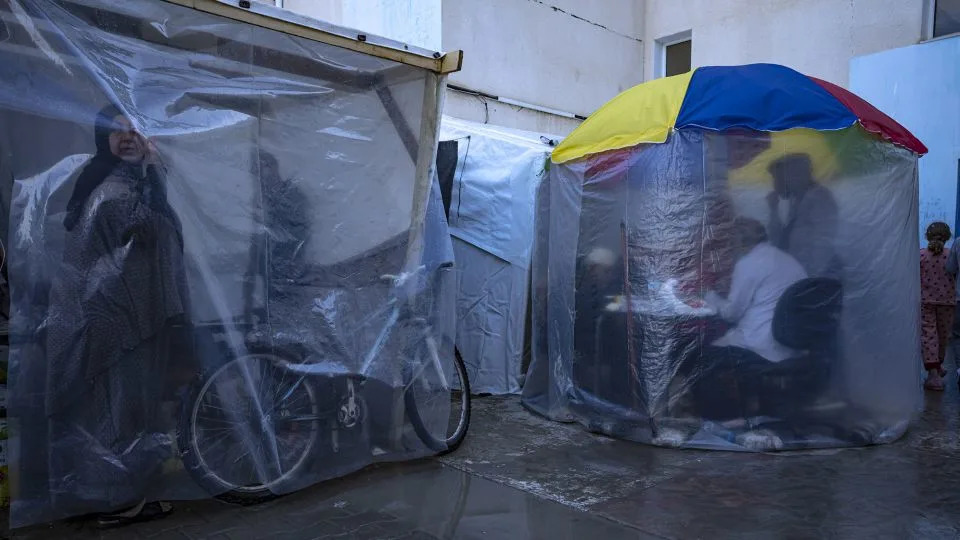
Palestinians displaced by Israeli strikes try to seek cover from rainfall at a UN tent camp in Khan Younis, in southern Gaza, on November 19. Swathes of land in Gaza have turned into tent camps, where thousands of civilians are living in cramped and unsanitary conditions. - Fatima Shbair/AP
Some displaced children in a tent camp in Deir Al-Balah, in southern Gaza, could be seen playing in the water following intense downpours on Tuesday.
But Rana Al-Najjar, a 13-year-old girl walking around barefoot, told CNN she found no joy in the rain.
“We are nine people living in this tent. Our tent is flooded with water, my siblings are freezing, and we don’t know what to do. We want to go back to our homes and not drown,” she said.
‘I see people starving’
Israel’s Coordinator of Government Activities in the Territories (COGAT), says it is “facilitating various humanitarian aid initiatives” to help the civilian population in Gaza, including allowing in aid deliveries – subject to security checks – supplying water and facilitating the establishment of field hospitals. On Tuesday, four tankers of fuel and two tankers of cooking gas were allowed in, as well as 195 trucks of humanitarian aid, COGAT said.
But this is far from meeting the needs of displaced Palestinians. Essential goods have become hard to find – and are expensive when available. People walk for hours or stand in long queues to buy food and fuel, civilians told CNN.
The price of food and water has surged as supplies diminish, leading to widespread hunger and dehydration. The World Food Programme declared a “catastrophic hunger crisis” in Gaza on December 5. The relief organization said it was forced to shut down its last remaining bakery because it had no fuel or gas, adding that it ran 23 bakeries before the war.
Reduced daylight hours mean people are less able to rely on solar power for generators needed to power water pumps. Tibi, the mother of four in Rafah, saves mineral water for the children and infants. The adults drink water sent through aid trucks, she said, which is “not 100% clean.”
Adults ration their meals so that children do not go hungry. “I see people starving, literally starving,” said Bleha, who eats one meal a day.
Civilians on the ground relayed to CNN how much costs have increased in recent weeks. In some cases, the price of 1.5 liters of water has risen from two shekels (about 50 cents) to five shekels, said Ghalayini. A kilogram of cucumbers worth one shekel could go for five or six shekels, while the price of flour, normally 40 shekels per 25-kilogram bag, reached 200 shekels in recent weeks. One displaced family in Deir Al-Balah told CNN they were paying 140 shekels ($38) for 1,000 liters of non-drinkable water.
Aid workers described surviving on a diet of canned beans, bread, and hummus because they cannot cook their food without fuel. Others have set up makeshift cooking facilities in clay ovens, and over open fires, burning solid fuels like plastic, wood, garbage and cardboard instead of cooking with electricity or gas. Some use tin rocket stoves, where wood is burned in a vertical heat chamber to reduce smoke fumes, according to the UN’s children’s agency.
Those relying on solid fuels to heat indoor spaces are exposed to potential carbon monoxide poisoning, said Ghalayini. Outside, street vendors are using burnable waste for fuel, which can release toxic fumes such as black carbon. Cars powered by cooking oil or corn oil release “huge plumes of black smoke” into the atmosphere, he added.
The price of automotive transport has increased six-fold, according to Jamal Al Rozzi, executive director of the National Society for Rehabilitation, who has fled to Bani Suhelia, in the south, for his children’s safety. The cost of moving goods in carts pulled by horses or donkeys has tripled, he added.
Diseases ‘spread like wildfire’
For those already struggling to stay safe, warm and fed, illness poses an additional risk.
In crowded shelters that cannot meet basic sanitation and hygiene needs, diseases “spread like wildfire,” said Inglis, the intensive care doctor.
She anticipates an uptick in upper respiratory tract infections because coughs, colds and viruses spread more quickly when people are clustered together without proper ventilation. Civilians will be exposed to other illnesses including diarrhea and hepatitis A, as well as body lice and scabies, because they cannot wash properly, Inglis added.
Roughly 160,000 to 165,000 cases of diarrhea have been recorded among children under the age of five, a WHO official said Tuesday, describing the figure as “much more” than usual. More than 130,000 cases of respiratory tract infections and 35,000 cases of skin rashes have been recorded, the Hamas-controlled health ministry in Gaza said in a report Monday, as well as thousands of cases of chickenpox, lice and scabies.
A colleague in southern Gaza, Inglis said, had told her of treating people with wounds “full of maggots” and elderly people suffering “dehydration and exhaustion” after fleeing from the north to the south.
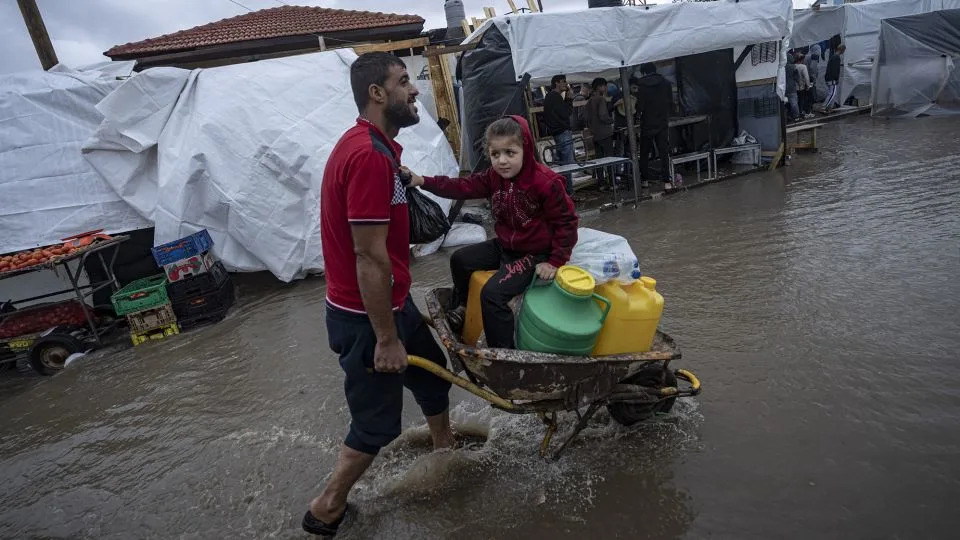
A man carries his daughter in a wheelbarrow through the flooded streets of a UN displacement camp in Khan Younis, in southern Gaza, on November 19. Infectious diseases including diarrhea, jaundice, acute hepatitis and respiratory infections are spreading in the strip. - Fatima Shbair/AP
Vulnerable populations, including malnourished children, pregnant and menstruating women, and those with disabilities, are more likely to have symptoms that are left untreated. Israel’s complete siege and restrictions on aid entering Gaza have diminished drug supplies, leaving health workers unable to help many patients who are sick or treat those who have suffered injuries in the bombardment, increasing their risk of infection.
Barakat, in Khan Younis, said: “I and many of my children got sick with several viruses that have spread recently, namely the flu and many colds, and other unknown but painful and contagious viruses.”

Displaced Palestinians queue for food donations in Rafah, in southern Gaza, on November 30. Rampant food, fuel and water shortages have led to spiraling prices. - Mohammed Abed/AFP/Getty Images
Civilians with chronic illnesses including diabetes and high blood pressure are also more vulnerable to winter illnesses because the blockade has prevented access to treatment, said Inglis.
“Hospitals are not receiving enough medication so there is huge suffering on many levels,” Al Rozzi told CNN.
In Gaza, there are more than 2,000 cancer patients, 1,000 people with kidney disease, 50,000 people with cardiovascular disease and 60,000 diabetes patients, according to WHO. Poorly controlled Type 2 diabetes can lead to complications including skin infections, heart attacks or strokes, Inglis said, adding that patients with treatable cancer are “going to die.”
About 359 patients are accessing dialysis units in the south, the Hamas-run Ministry of Health in Gaza told CNN on December 11. Inglis said dialysis patients require treatment two to three times a week. The largest dialysis unit in Al-Shifa, the largest hospital in Gaza, was forced to close after the Israeli military raided the hospital. It has since re-opened with severely limited capacity.
The number of functioning hospitals along the strip has plummeted from 36 to 11, WHO said.
“The entire system has been systematically destroyed in this conflict in such a way that it will take years to rebuild,” said Inglis.
Al-Rozzi said Palestinians were in a state of “fear, anxiety and pain,” adding: “They feel worthless, and they have no clear view of tomorrow, or today.”
Barakat called on the international community to protect Palestinian lives, in the hope that peace will return to Gaza.
“Enough siege, enough starvation, enough killing, enough abuse, we have the right to live,” he said. “Our children have the right to play.”
CNN’s Ibrahim Dahman, Abeer Salman, Mostafa Salem, Kareem Khadder, Eyad Kourdi, Derek Van Dam and Niamh Kennedy contributed reporting.
Gaza faces 'perfect storm' of deadly diseases
Wed, December 13, 2023
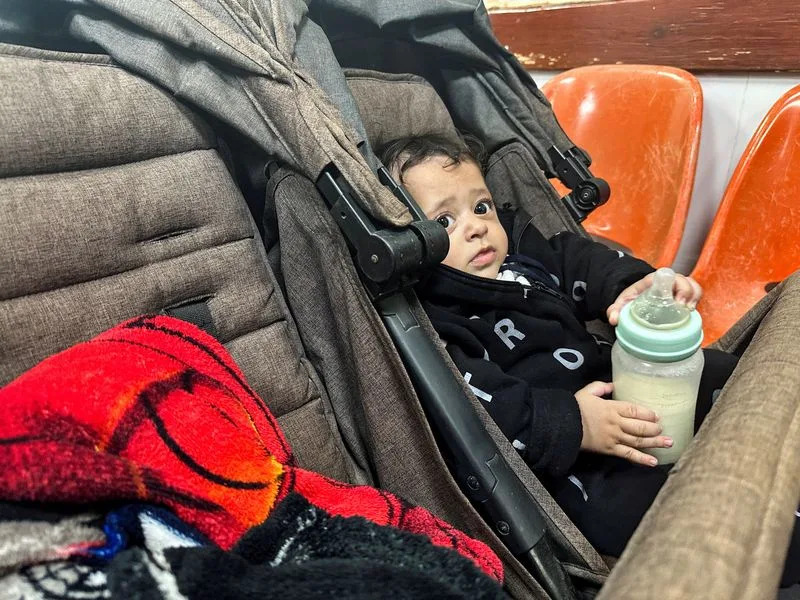
Doctors warn of the spread of diseases among Gazan children as the conflict continues, in Rafah, in the southern Gaza Strip
By Bassam Masoud and Saleh Salem
GAZA (Reuters) - For the besieged residents of Gaza who have so far survived Israel's bombs and bullets, a silent, invisible killer is now stalking them: disease.
A lack of food, clean water and shelter have worn down hundreds of thousands of traumatised people and, with a health system on its knees, it's inevitable epidemics will rip through the enclave, 10 doctors and aid workers told Reuters.
"The perfect storm for disease has begun. Now it's about, 'How bad will it get?'" James Elder, chief spokesperson for the U.N. children's fund (UNICEF), said in an interview on Tuesday.
From Nov. 29 to Dec. 10, cases of diarrhoea in children under five jumped 66% to 59,895 cases, and climbed 55% for the rest of the population in the same period, according to data from the World Health Organization (WHO). The U.N. agency said the numbers were inevitably incomplete due to the meltdown of all systems and services in Gaza because of the war.
The head of the paediatric ward at Nasser Hospital in Khan Younis in southern Gaza, Dr. Ahmed Al-Farra, told Reuters on Tuesday his ward was overrun with children suffering extreme dehydration, causing kidney failure in some cases, while severe diarrhoea was four times higher than normal.
He said he was aware of 15 to 30 cases of Hepatitis A in Khan Younis in the past two weeks: "The incubation period of the virus is three weeks to a month, so after a month there will be an explosion in the number of cases of Hepatitis A."
Since the truce between Israel and Hamas collapsed on Dec. 1, hundreds of thousands of people have moved to makeshift shelters - abandoned buildings, schools and tents. Many others are sleeping in the open with little access to toilets or water to bathe, aid workers said.
At the same time, 21 of the Gaza Strip's 36 hospitals are closed, 11 are partially functional and four are minimally functional, according to WHO figures from Dec. 10.
Marie-Aure Perreaut, emergency medical coordinator for MSF's operations in Gaza, said the medical charity had left a health centre in Khan Younis 10 days ago - because the area was within Israel's evacuation orders - where it had been treating respiratory tract infections, diarrhoea and skin infections,
She said two things were now inevitable.
"The first is an epidemic of something like dysentery will spread across Gaza, if we continue at this pace of cases, and the other certainty is that neither the ministry of health nor the humanitarian organisations will be able to support the response to those epidemics," she said.
'PRACTICE OF MEDICINE IS UNDER ATTACK'
Academic researchers at the London School of Hygiene & Tropical Medicine warned in a Nov. 6 report - a month after the Hamas attack on Israel triggered the Gaza war - of how the indirect health effects of the conflict would worsen over time.
They said that two months into the war there would be an increased burden of infant malnutrition due to disrupted feeding and care, and the nutrition of mothers would worsen. "With time, increasing chance of introduction of epidemic-prone pathogens. Risk factors: overcrowding, inadequate (water and sanitation)."
Aid workers say what the experts in London predicted is exactly what's playing out now. Three experts said diseases such as dysentery and watery diarrhoea could end up killing as many children as Israeli bombardments have done so far.
The U.N. aid agency for Palestinian refugees (UNRWA) said two months of brutal war combined with a "very tight siege" have forced 1.3 million Gazans out of a population of 2.3 million to seek safety at its sites in the strip of land by the Mediterranean Sea.
"Many of the shelters are overwhelmed with people seeking safety, with four or five times their capacity," said Juliette Touma, UNRWA's director of communications. "Most of the shelters are not equipped with toilets or showers or clean water."
Since the war started, 135 staff of UNRWA have been killed and 70% of staff have fled their homes, two of the reasons why UNRWA is now operating only nine of the 28 primary health clinics it had prior to the war, Touma said.
All told, at least 364 attacks on healthcare services have been recorded in Gaza since Oct. 7, U.N. special rapporteur on the right to health, Tlaleng Mofokeng, said in Dec. 7 statement.
"The practice of medicine is under attack," she said.
More than 300 Gazan health ministry staff and medics have been killed since Oct. 7, the ministry said on Wednesday.
'EPIDEMIC POTENTIAL'
Salim Namour, a Syrian surgeon who treated the sick and wounded in eastern Ghouta outside Damascus during a years-long siege imposed by the Syrian government, said the images from Gaza reminded him of the scenes he experienced first-hand.
He said hepatitis and tuberculosis spread in Ghouta as its sewage system was destroyed and water contaminated. Malnutrition weakened people's immunity and - setting aside wounds caused by shelling - shortages of antibiotics and vaccines for children encouraged the spread of disease.
"Siege ... is a way to cause society to collapse. It means hunger, it means shortages of medical supplies, no electricity, no refrigeration, no way to preserve medicines or food, no heating," said Namour, who left Ghouta in 2018 and lives in Germany.
Gaza's health ministry said on Wednesday its supplies of childhood vaccines had run out. Overnight on Wednesday, strong winds and heavy rain ripped the flimsy tents at a camp in Rafah and flooded the ground, forcing people to spend the night huddled in the cold on wet sand.
The United Nations is tracking the incidence of 14 diseases with "epidemic potential" and is most concerned about soaring rates of dysentery, watery diarrhoea, and acute respiratory infections, according to a list the U.N. is currently using for Gaza seen by Reuters on Tuesday.
Dr. Paul Spiegel, director of the Center for Humanitarian Health at the John Hopkins Bloomberg School of Public Health, who is in Cairo working on the U.N. response, said a diarrhoea outbreak could happen as soon as tomorrow, unless many more aid trucks were let in and clean water was provided.
He also said the U.N. plans to start documenting the levels of acute malnutrition among children in Gaza soon by measuring their mid-upper arm circumference, known as a MUAC test.
"When you have acute malnutrition, which is called wasting, people, they die from that, but then they are also so much more vulnerable to other diseases," said Spiegel.
The U.N.'s World Food Programme said on Monday that 83% of the people who have moved to southern Gaza were not eating enough food.
'UNFIT FOR HUMAN CONSUMPTION'
To avoid epidemics, aid workers said hospitals and health centres would need to be able to treat large numbers of people for such diseases, instead of only the trauma wounds they're already overwhelmed with.
Drinking and bathing water would need to be available at minimum required levels according to emergency humanitarian standards while greater amounts of food and medicine would need to come into the Gaza Strip and safe passage provided for humanitarian convoys to deliver it, the aid workers said.
During the recent truce, about 200 aid trucks a day entered Gaza but that has since dwindled to 100 and fierce fighting has mostly prevented any distribution beyond Rafah.
Doctors at Abu Yousef al-Najjar Hospital in Rafah told Reuters on Tuesday they were overwhelmed with hundreds of patients needing treatment for infections and communicable diseases given the squalid conditions in overcrowded shelters.
"There will be outbreaks of all contagious diseases across Rafah," said Dr. Jamal Al-Hams.
Nasser Hospital's paediatric head Al-Farra said ongoing hostilities had made it impossible for many families to bring their ill children for care in time, which in any case he could not provide adequately due to shortage of medicines.
"Children are (drinking) water that is unfit for human consumption," he said. "There's no fruit, no vegetables, so children have a deficiency in vitamins, in addition to ... anaemia from malnutrition."
Without clean water to mix with infant formula, doctors and aid workers said, babies were going hungry too. Even relatively well-off Gazans working for international agencies or media companies said their children were now ill and did not have enough food or water.
Standing among a sea of tents near Nasser Hospital, Mahmoud Abu Sharkh, who fled northern Gaza early in the war with his three children who are all under three, pointed to the squalid conditions around him in the dusty camp.
"The children get better for two days, and on the third day they are sick again."
(Reporting by Bassam Massoud and Saleh Salem in Gaza; Additional reporting by Maggie Fick and Edmund Blair in London, Emma Farge and Gabrielle Tetrault-Farber in Geneva, and Tom Perry in Beirut; Writing by Maggie Fick; Editing by David Clarke)
Israel strikes southern Gaza as disease stalks residents
Wed, December 13, 2023
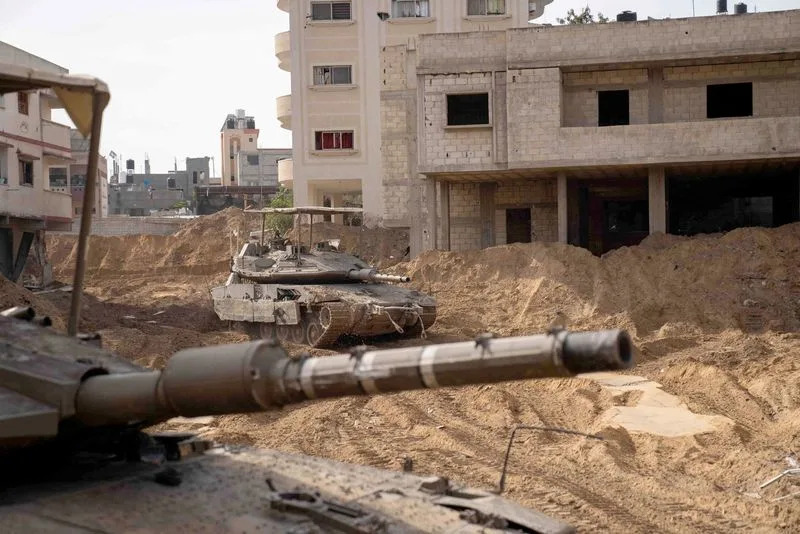
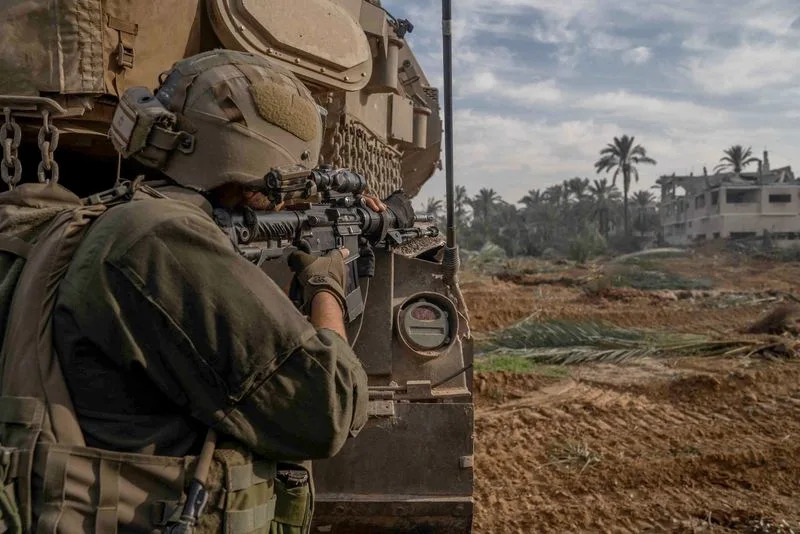
Israeli military vehicles operate in the Gaza Strip amid the ongoing conflict between Israel and the Palestinian Islamist group Hamas
By Nidal al-Mughrabi and Fadi Shana
CAIRO/GAZA (Reuters) -Israel kept up its barrage of the Gaza Strip on Thursday despite intensifying international calls to reduce civilian casualties from its bombardment as a surge in deadly diseases sweeps through displaced residents.
Israel says its attacks on Gaza are aimed at annihilating Hamas, the group whose fighters stormed across the border fence from Gaza on Oct. 7, killing 1,200 Israelis, mostly civilians, and seizing 240 hostages.
Since then, Israel has laid much of the Palestinian enclave to waste. At least 18,608 people have been killed and 50,594 injured in Israeli strikes on Gaza, according to Gaza's health ministry.
The vast majority of the population of 2.3 million has fled their homes, leaving them vulnerable to illnesses including gastroenteritis and Hepatitis A, Palestinian doctors and aid organisations say.
"What's happening is that people are fleeing, people are being displaced constantly, some of them are being displaced multiple times, many of them don't have the hygiene supplies that they need, many of them don't have the winter clothes," said Juliette Touma, director of communications at the United Nations Relief and Works Agency (UNRWA).
The coastal strip is now facing a public health disaster due to the collapse of its health system and the spread of disease, the U.N. humanitarian office said.
"We've got a textbook formula for epidemics and a public health disaster," said Lynn Hastings, the U.N. Humanitarian Coordinator for the Occupied Palestinian Territory.
In central Rafah, in the south of the coastal enclave, 24 people were killed in an Israeli strike that hit two houses, Hamas media said early on Thursday. There was no immediate confirmation from the Palestinian health ministry.
White House national security adviser Jake Sullivan, who is visiting the region and will be in Israel on Thursday and Friday, would discuss with the Israelis the need to be more precise with their strikes against Hamas targets, spokesperson John Kirby told reporters.
Nearly half of the air-to-ground munitions that Israel has used in Gaza in its war with Hamas since Oct. 7 have been unguided, otherwise known as "dumb bombs," according to a new U.S. intelligence assessment reported by CNN.
The news outlet said the assessment was compiled by the Office of the Director of National Intelligence and described to CNN by three sources who have seen it.
About 40-45% of the 29,000 air-to-ground munitions Israel has used have been unguided and the rest have been precision-guided munitions, the CNN report added.
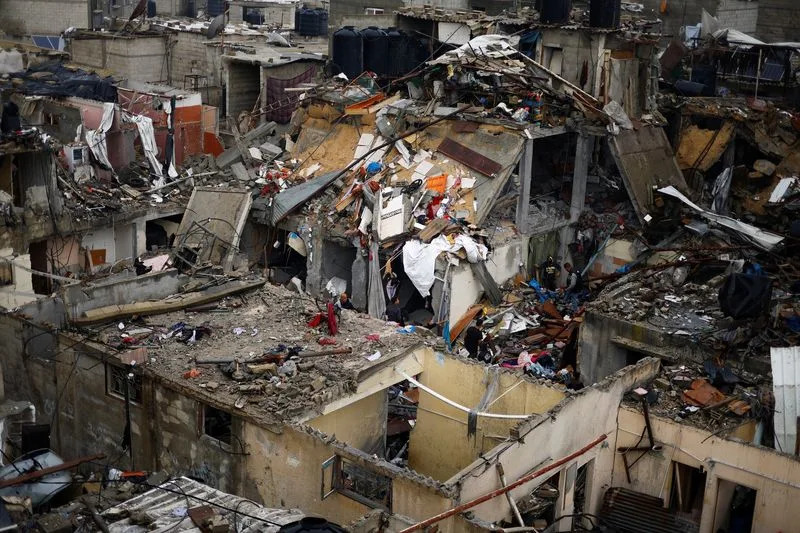
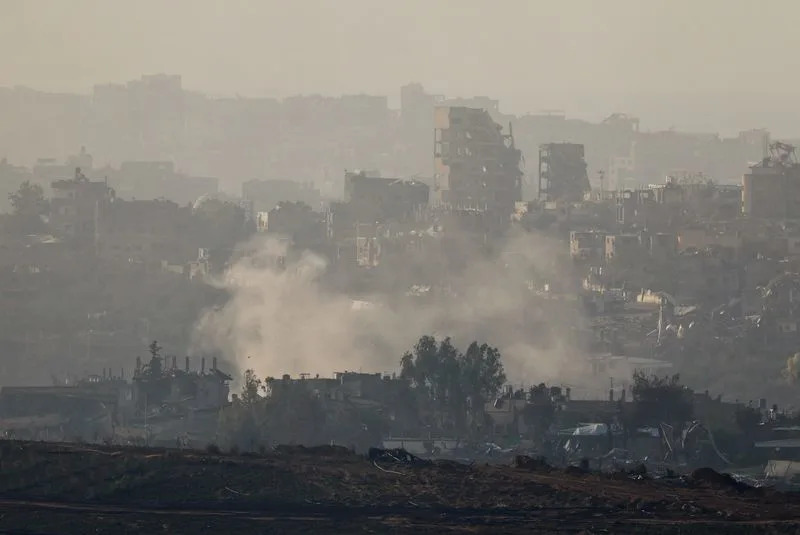
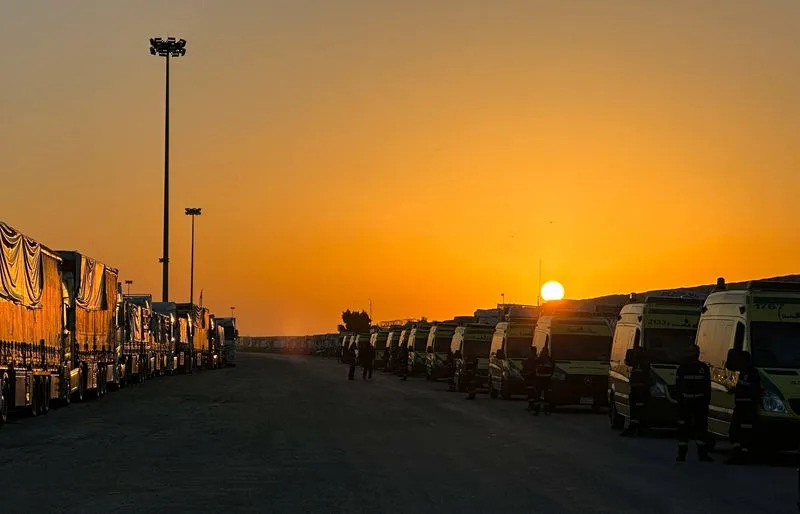
Ambulances and aid trucks waiting to enter Gaza strip from the side of Rafah
TANKER ATTACKED
Fears of the conflict spreading in a volatile region remain.
A tanker in the Red Sea off Yemen's coast was fired on by gunmen in a speedboat and targeted with missiles, maritime sources said on Wednesday. It is the latest incident to threaten the vital shipping lane after Yemeni Houthi forces, which are backed by Iran, warned ships not to travel to Israel.
The cost of the Israel-Hamas war to neighbours Lebanon, Egypt and Jordan in terms of loss of GDP may amount to $10.3 billion or 2.3%, and might double if the conflict lasts six more months, a study commissioned by the U.N. Development Programme said.
The Biden administration is delaying the sale to Israel of more than 20,000 U.S.-made rifles over concerns about increasing attacks by Israeli settlers on Palestinians in the West Bank, two sources familiar with the matter said.
Some 271 Palestinians have been killed by Israeli security forces, including 69 children, in the occupied West Bank this year, the U.N. Palestinian refugee agency said.
At least 288 displaced people in shelters run by the agency have been killed in Gaza since Oct. 7, the agency added in a post on X.
The number of Israeli soldiers killed in the ground offensive has reached 115, and more than 600 wounded, according to an Israeli military website.
"Your heroism, and of those who unfortunately fell and we couldn’t bring them to this state of rehabilitation, are the light which repels the darkness, and in this room there is so much light," Lieutenant General Herzi Halevi, chief of Israel's General Staff, told injured soldiers during a ceremony for the Jewish festival of Hanukkah in Ramat Gan.
PROTESTS, VIGILS
Some Biden administration staffers held a vigil in front of the White House late on Wednesday to call on Washington to support a ceasefire in Gaza.
The group of around 60 people carried a banner that read: "President Biden, your staff demands a ceasefire."
"We were horrified by the brutal October 7 attacks on Israeli civilians, and have been horrified by the disproportionate response by the Israeli government, which has indiscriminately killed thousands of innocent Palestinian civilians in Gaza and displaced over a million more," the protesters said in a statement read by Josh Paul, a former State Department official who resigned a few weeks ago.
In New York, a demonstration was held demanding the release of the remaining 135 hostages held in Gaza.
Most Israelis say the army should not back off its unrelenting offensive to crush Hamas.
"It's awful. It's awful that there are so many civilian casualties," said Jerusalem resident Adam Saville. "But this is war, and that's what happens in war."
(Reporting by Nidal al-Mughrabi in Cairo, Fadi Shana in Gaza, Ilan Rosenberg and Frank Jack Daniel in Jerusalem, Humeyra Pamuk and Kanishka Singh in Washington and Reuters bureaux; Writing by Lincoln Feast; Editing by Stephen Coates)
Fears of the conflict spreading in a volatile region remain.
A tanker in the Red Sea off Yemen's coast was fired on by gunmen in a speedboat and targeted with missiles, maritime sources said on Wednesday. It is the latest incident to threaten the vital shipping lane after Yemeni Houthi forces, which are backed by Iran, warned ships not to travel to Israel.
The cost of the Israel-Hamas war to neighbours Lebanon, Egypt and Jordan in terms of loss of GDP may amount to $10.3 billion or 2.3%, and might double if the conflict lasts six more months, a study commissioned by the U.N. Development Programme said.
The Biden administration is delaying the sale to Israel of more than 20,000 U.S.-made rifles over concerns about increasing attacks by Israeli settlers on Palestinians in the West Bank, two sources familiar with the matter said.
Some 271 Palestinians have been killed by Israeli security forces, including 69 children, in the occupied West Bank this year, the U.N. Palestinian refugee agency said.
At least 288 displaced people in shelters run by the agency have been killed in Gaza since Oct. 7, the agency added in a post on X.
The number of Israeli soldiers killed in the ground offensive has reached 115, and more than 600 wounded, according to an Israeli military website.
"Your heroism, and of those who unfortunately fell and we couldn’t bring them to this state of rehabilitation, are the light which repels the darkness, and in this room there is so much light," Lieutenant General Herzi Halevi, chief of Israel's General Staff, told injured soldiers during a ceremony for the Jewish festival of Hanukkah in Ramat Gan.
PROTESTS, VIGILS
Some Biden administration staffers held a vigil in front of the White House late on Wednesday to call on Washington to support a ceasefire in Gaza.
The group of around 60 people carried a banner that read: "President Biden, your staff demands a ceasefire."
"We were horrified by the brutal October 7 attacks on Israeli civilians, and have been horrified by the disproportionate response by the Israeli government, which has indiscriminately killed thousands of innocent Palestinian civilians in Gaza and displaced over a million more," the protesters said in a statement read by Josh Paul, a former State Department official who resigned a few weeks ago.
In New York, a demonstration was held demanding the release of the remaining 135 hostages held in Gaza.
Most Israelis say the army should not back off its unrelenting offensive to crush Hamas.
"It's awful. It's awful that there are so many civilian casualties," said Jerusalem resident Adam Saville. "But this is war, and that's what happens in war."
(Reporting by Nidal al-Mughrabi in Cairo, Fadi Shana in Gaza, Ilan Rosenberg and Frank Jack Daniel in Jerusalem, Humeyra Pamuk and Kanishka Singh in Washington and Reuters bureaux; Writing by Lincoln Feast; Editing by Stephen Coates)
Gaza faces public health disaster, UN humanitarian office says
Reuters
Updated Wed, December 13, 2023
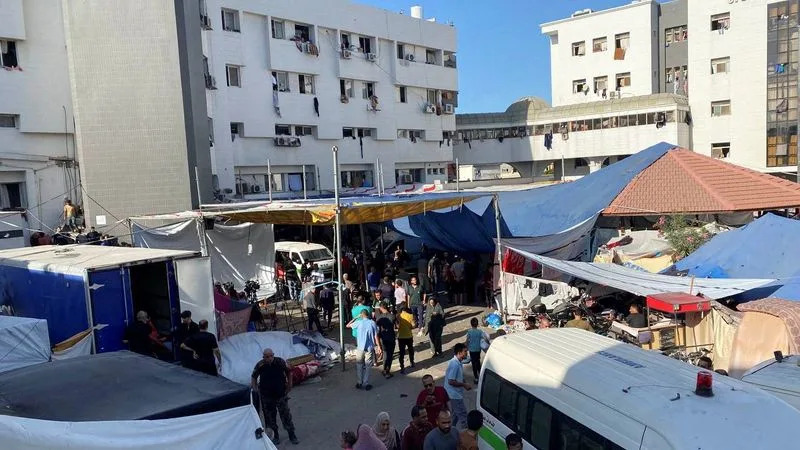
People, including Palestinian children, who fled their house due to Israeli strikes, gather at Al Shifa hospital where they shelter
GENEVA (Reuters) -The U.N. humanitarian office said on Wednesday that Gaza faced a public health disaster due to the collapse of its health system and the spread of disease amid an offensive by Israel that has hit hospitals and displaced hundreds of thousands of people.
The United Nations and aid groups have sounded the alarm about the spread of infectious disease in Gaza, where the internal displacement of 85% of the population has caused overcrowding in shelters and other temporary living facilities.
Israel, which went to war in Gaza after the Palestinian enclave's ruling Hamas militants launched a devastating attack on its southern communities on Oct. 7, has told civilians to flee battle zones and says it seeks avert humanitarian distress.
"We all know that the health care system is or has collapsed," said Lynn Hastings, the U.N. Humanitarian Coordinator for the Occupied Palestinian Territory.
"We've got a textbook formula for epidemics and a public health disaster."
WHO has reported a sharp rise in acute respiratory infections, diarrhoea, lice, scabies and other fast-spreading diseases.
Hastings said people in Gaza had to line up for hours just to access a toilet.
"You can imagine what the sanitation conditions are like," she said.
WHO said on Tuesday that only 11 of Gaza's 36 hospitals were partially functional, one in the north and 10 in the south of the enclave.
In Jerusalem, a senior Israeli lawmaker from Prime Minister Benjamin Netanyahu's Likud party, said field hospitals had been erected within Gaza by the United Arab Emirates and Jordan.
"We offered every possible help (and) we are prepared to do more," Yuli Edelstein, chairman of the Israeli parliament's Foreign Affairs and Defence Committee, told Reuters.
"But one thing has to be clear. There is overlapping between medical system and hospitals and Hamas terrorist activities," he said, reiterating Israeli allegations - denied by Hamas - that the Palestinian militants have been operating within hospitals.
"So this is not something that we will tolerate."
Hasting said that almost half of Gaza's population of 2.3 million was now in Rafah in the southern tip of the enclave to escape Israeli bombardment.
"This is leading to nothing but a health crisis," she said.
(Reporting by Gabrielle Tétrault-Farber, Editing by Kirsti Knolle and Angus MacSwan)
Bloody diarrhea, jaundice, hepatitis: Thousands fall ill in war-ravaged Gaza amid spike in infectious diseases
Nadeen Ebrahim, CNN
Tue, December 12, 2023
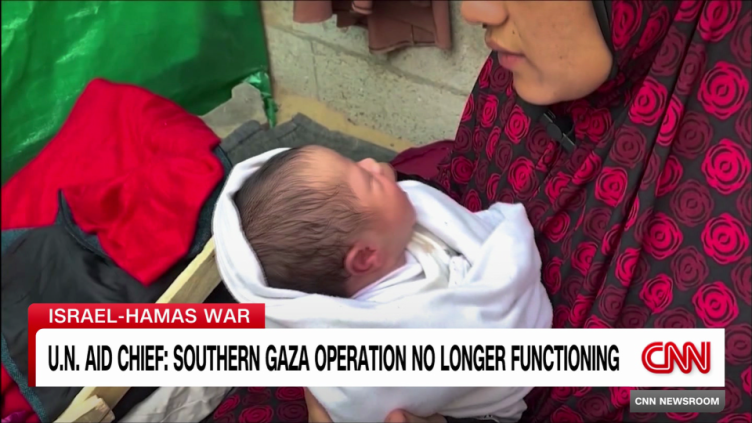
Bloody diarrhea, jaundice, acute hepatitis and respiratory infections. These are just some of the diseases spreading in the Gaza Strip, where the World Health Organization (WHO) says the health system is “on its knees and collapsing.”
As the war between Israel and Hamas enters its third month, medics and aid groups are sounding alarm bells on the humanitarian situation in the besieged enclave – where the United Nations is worried that more people may end up dying of diseases than from bombs and missiles.
The coastal territory – which the Hamas militant group controls – has been under complete siege by Israel since the beginning of Israel’s war with Hamas, when the Palestinian group launched an October 7 attack on Israel, killing 1,200 people and kidnapping 240 others, according to Israeli authorities.
Most of the Strip has run out of food, potable water, electricity and medical supplies as hundreds of thousands of displaced Palestinians crowd into small spaces to shelter from Israel’s bombs.
Apart from foreign nationals and a small number of injured Palestinians, almost no one has been able to escape Gaza, where more than 2 million people remain trapped.
More than 18,000 people have been killed in Gaza since the fighting broke out, the Hamas-controlled health ministry in the enclave said Monday.
Here’s what we know about the potential for disease to spread in the territory.
How has the healthcare system been affected by the war?
Local doctors and the UN have for weeks been warning of deadly outbreaks, with the WHO last month saying that the crisis in Gaza is a “recipe for epidemics.”
In remarks to WHO member countries, Director-General Tedros Adhanom Ghebreyesus on Sunday said that only 14 hospitals out of 36 in Gaza are functional, with the two main hospitals in the south operating at three times their capacity.
Only two are left operating north of Wadi Gaza, he said, which Israel had asked some 1.1 million people to evacuate south of as it began its ground operation on October 13. Just 1,400 hospital beds are left, he added, with medical facilities running out of supplies while acting as makeshift shelters for the displaced.

Palestinians flock to a truck carrying drinkable water amid growing hunger and thirst in Rafah, southern Gaza on December 11. - Anadolu/Getty Images
What diseases are medics worried about?
The WHO chief said there were worrying signals of epidemic diseases “including bloody diarrhea and jaundice,” adding that there have also been reports of high levels of diarrheal diseases and respiratory infections.
Other diseases reported in Gaza include measles, meningitis, chickenpox and acute viral hepatitis, according to the Palestinian Ministry of Health in Gaza.
Richard Peeperkorn, WHO Representative in the Occupied Palestinian Territory, on Tuesday said there are between 160,000 to 165,000 cases of diarrhea among children under the age of five, which is “much more” than in normal times.
Diarrheal diseases are believed to be the second leading cause of death in children under five years old. Left untreated, diarrhea can last several days, leaving the body without the water and salts needed for survival.
The Palestinian Ministry of Health has also reported more than 133,000 cases of upper respiratory tract infection (URTI) – a viral infection that can affect the nose, throat and sinuses – more than 17,000 cases of lice and nits, some 35,000 cases of skin rashes and more than 1,900 cases of food poisoning.
The ministry has not reported any cases of cholera, but Médecins Sans Frontières (MSF), also known as Doctors Without Borders, has repeatedly warned of a potential cholera outbreak amid a lack of clean water in overcrowded areas.
“Many are drinking salty or contaminated water, which can make people sick,” MSF said in October.
Cholera has spread during wars in Yemen, Syria and Sudan in recent years.
Euro-Med Human Rights Monitor warned last month that bodies near or in water sources may also lead to contamination, increasing the risk of cholera and other gastrointestinal diseases.
Other diseases, including blood-borne viruses and tuberculosis, may result from the public decomposition of dead bodies for long periods of time, a common occurrence amid the war in Gaza.
The WHO chief said there were worrying signals of epidemic diseases “including bloody diarrhea and jaundice,” adding that there have also been reports of high levels of diarrheal diseases and respiratory infections.
Other diseases reported in Gaza include measles, meningitis, chickenpox and acute viral hepatitis, according to the Palestinian Ministry of Health in Gaza.
Richard Peeperkorn, WHO Representative in the Occupied Palestinian Territory, on Tuesday said there are between 160,000 to 165,000 cases of diarrhea among children under the age of five, which is “much more” than in normal times.
Diarrheal diseases are believed to be the second leading cause of death in children under five years old. Left untreated, diarrhea can last several days, leaving the body without the water and salts needed for survival.
The Palestinian Ministry of Health has also reported more than 133,000 cases of upper respiratory tract infection (URTI) – a viral infection that can affect the nose, throat and sinuses – more than 17,000 cases of lice and nits, some 35,000 cases of skin rashes and more than 1,900 cases of food poisoning.
The ministry has not reported any cases of cholera, but Médecins Sans Frontières (MSF), also known as Doctors Without Borders, has repeatedly warned of a potential cholera outbreak amid a lack of clean water in overcrowded areas.
“Many are drinking salty or contaminated water, which can make people sick,” MSF said in October.
Cholera has spread during wars in Yemen, Syria and Sudan in recent years.
Euro-Med Human Rights Monitor warned last month that bodies near or in water sources may also lead to contamination, increasing the risk of cholera and other gastrointestinal diseases.
Other diseases, including blood-borne viruses and tuberculosis, may result from the public decomposition of dead bodies for long periods of time, a common occurrence amid the war in Gaza.
What’s causing the diseases and why are they spreading?
After Israel imposed a blockade on Gaza on October 9, the enclave quickly began running out of food and drinking water. Fuel supplies have dwindled, leaving the population with little to no electricity to power medical facilities, refrigerate food or even store bodies killed in the fighting.
Israel is now expanding its military operation deeper into southern Gaza, telling civilians to evacuate areas they had moved to following the military’s call to evacuate the north.
Almost all of Gaza’s population – 1.9 million out of the more than 2 million in the enclave – is now displaced, the WHO said Sunday.
There are few places to move to, and hundreds of thousands are moving into more crowded areas. The UN estimates at least 60% of Gaza’s housing has been destroyed or damaged as of November 24.
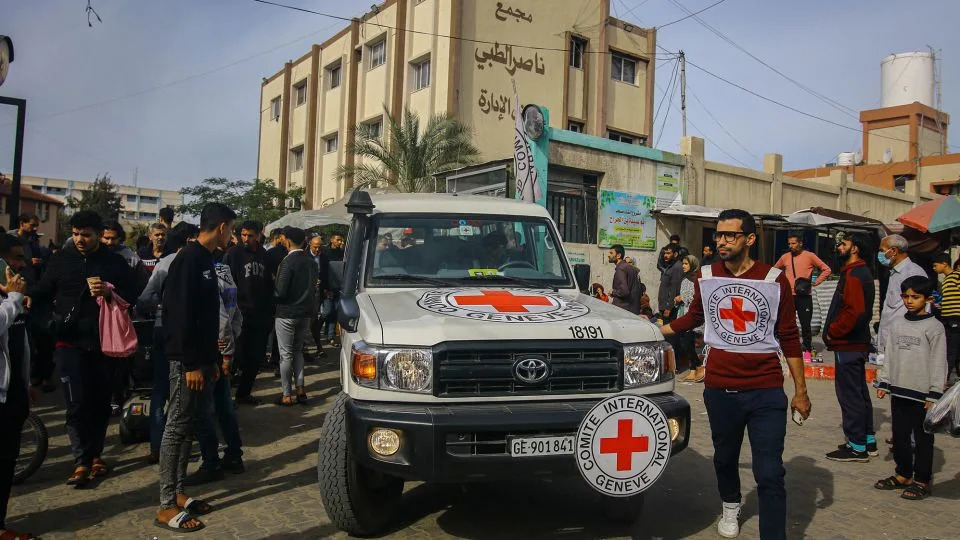
Medical aid from the International Committee of the Red Cross (ICRC) arrives at the Nasser Medical Hospital in Khan Younis, southern Gaza, on December 9.
- Ahmad Salem/Bloomberg/Getty Images
How is the international community reacting?
The UN General Assembly will on Tuesday resume its emergency session on the situation in Gaza, days after the United States vetoed a UN Security Council resolution calling for a humanitarian ceasefire.
UN staff in Gaza feel abandoned after the US veto, Philippe Lazzarini, the head of the UN Relief and Works Agency for Palestinian refugees (UNRWA) said on Monday. They “cannot understand” why a ceasefire has not been agreed on after thousands have been killed and displaced, he said in the Egyptian city of Arish, close to the Rafah crossing with Gaza.
Gaza is “very close” to seeing “a breakdown of civil order,” which will not allow the agency to operate any more, he said, noting how some civilians in Gaza have resorted to looting warehouses in desperation.
In recent days, between 60 and 100 trucks have been using Rafah crossing to enter Gaza – a volume aid groups say is too little to mitigate the territory’s humanitarian crisis.
It is unclear when more aid will make it into Gaza, but Israeli authorities said Monday that two crossings it shares with Gaza – Kerem Shalom and Nitzana – will be used to help screen humanitarian aid destined for the territory, noting that no aid will be allowed directly into Gaza from either crossing in Israel.
The aid will be screened at both crossings then forwarded from there to international aid organizations in the Gaza Strip via Rafah in Egypt, Israel said.
CNN’s Kareem Khadder, Niamh Kennedy, Clarissa Ward, Catherine Nicholls, Tamar Michaelis and Tim Lister contributed to this report.
Israeli troops storm Gaza hospital as disease spreads among displaced Palestinians
The UN General Assembly will on Tuesday resume its emergency session on the situation in Gaza, days after the United States vetoed a UN Security Council resolution calling for a humanitarian ceasefire.
UN staff in Gaza feel abandoned after the US veto, Philippe Lazzarini, the head of the UN Relief and Works Agency for Palestinian refugees (UNRWA) said on Monday. They “cannot understand” why a ceasefire has not been agreed on after thousands have been killed and displaced, he said in the Egyptian city of Arish, close to the Rafah crossing with Gaza.
Gaza is “very close” to seeing “a breakdown of civil order,” which will not allow the agency to operate any more, he said, noting how some civilians in Gaza have resorted to looting warehouses in desperation.
In recent days, between 60 and 100 trucks have been using Rafah crossing to enter Gaza – a volume aid groups say is too little to mitigate the territory’s humanitarian crisis.
It is unclear when more aid will make it into Gaza, but Israeli authorities said Monday that two crossings it shares with Gaza – Kerem Shalom and Nitzana – will be used to help screen humanitarian aid destined for the territory, noting that no aid will be allowed directly into Gaza from either crossing in Israel.
The aid will be screened at both crossings then forwarded from there to international aid organizations in the Gaza Strip via Rafah in Egypt, Israel said.
CNN’s Kareem Khadder, Niamh Kennedy, Clarissa Ward, Catherine Nicholls, Tamar Michaelis and Tim Lister contributed to this report.
Israeli troops storm Gaza hospital as disease spreads among displaced Palestinians
Patrick Hilsman
Tue, December 12, 202

An injured Palestinian woman walks to safety following Israeli bombardment at Al-Shaboura refugee camp in Rafah in the southern Gaza Strip on Tuesday. Israeli forces also stormed the Kamal Adwan hospital in northern Gaza Tuesday, according to the local Ministry of Health and U.N. officials.
Photo by Ismael Mohamad/UPI
Dec. 12 (UPI) -- Israeli forces stormed one of north Gaza's last functional healthcare facilities Tuesday, as international organizations warned that disease is spreading among millions of displaced people in Gaza.
The World Health Organization says that infectious diseases are spreading throughout Gaza, as Palestinians struggle to find food and water. According to the U.N. Relief and Works Agency, the body charged with Palestinian refugees, 1.9 million Palestinians have been displaced since Oct. 7.
The WHO has reported 369,000 cases of infectious diseases, according to the New York Times.
A spokesperson for the health organization said that staff are being "forcibly evacuated" from Kamal Adwan hospital, as the local Health Ministry says the Israeli military has stormed the healthcare facility.
The Israeli military had been laying siege to Kamal Adwan hospital for several days. The U.N. says that the hospital has been hit and that Palestinian Red Crescent Workers were detained and held at gunpoint.

The W.H.O. says disease is spreading across the Gaza strip as millions of displaced people struggle to access water, food, shelter and medical care.
Dec. 12 (UPI) -- Israeli forces stormed one of north Gaza's last functional healthcare facilities Tuesday, as international organizations warned that disease is spreading among millions of displaced people in Gaza.
The World Health Organization says that infectious diseases are spreading throughout Gaza, as Palestinians struggle to find food and water. According to the U.N. Relief and Works Agency, the body charged with Palestinian refugees, 1.9 million Palestinians have been displaced since Oct. 7.
The WHO has reported 369,000 cases of infectious diseases, according to the New York Times.
A spokesperson for the health organization said that staff are being "forcibly evacuated" from Kamal Adwan hospital, as the local Health Ministry says the Israeli military has stormed the healthcare facility.
The Israeli military had been laying siege to Kamal Adwan hospital for several days. The U.N. says that the hospital has been hit and that Palestinian Red Crescent Workers were detained and held at gunpoint.

The W.H.O. says disease is spreading across the Gaza strip as millions of displaced people struggle to access water, food, shelter and medical care.
File Photo by Ismael Mohamad/UPI
In a press release Tuesday, the U.N. Office of the Coordination for Humanitarian Affairs said that on Monday "the maternity department at Kamal Adwan hospital in Beit Lahiya, north of Gaza, was hit. As a result, two mothers were reportedly killed, and several people were injured."
According to the U.N. office, 3,000 internally displaced people "remain trapped in the facility and are awaiting evacuation with extreme shortages of water, food and power reported."

Gaza's Ministry of Health says over 18,000 people have been killed since Oct. 7.
In a press release Tuesday, the U.N. Office of the Coordination for Humanitarian Affairs said that on Monday "the maternity department at Kamal Adwan hospital in Beit Lahiya, north of Gaza, was hit. As a result, two mothers were reportedly killed, and several people were injured."
According to the U.N. office, 3,000 internally displaced people "remain trapped in the facility and are awaiting evacuation with extreme shortages of water, food and power reported."

Gaza's Ministry of Health says over 18,000 people have been killed since Oct. 7.
Photo by Ismael Mohamad/UPI
The organization painted a bleak picture of the situation on the ground.
"Large crowds wait for hours around aid distribution centers, in desperate need of food, water, shelter, health, and protection. In the absence of an adequate number of latrines, open air defecation is widespread, increasing concerns of the spread of disease, particularly during rains and flooding," the OCHA said.
WHO Director-General Tedros Ghebreyesus expressed concern about the situation at Kamal Adwan.
"I'm extremely worried about reports of a raid at Kamal Adwan Hospital in Gaza after several days of siege, Ghebreyesus wrote on X Tuesday. "According to the Ministry of Health, there are 65 patients including several needing intensive care, and 45 medical staff in the hospital."
Ghebreyesus said that hospital is suffering from "acute shortages of fuel, water, food and medical supplies even before the siege."
Gaza's Ministry of Health reports that fatality figures have surpassed 18,000 and that Israeli forces have detained the director of Kamal Adwan hospital.
‘We Are All Sick’: Infectious Diseases Spread Across Gaza
The organization painted a bleak picture of the situation on the ground.
"Large crowds wait for hours around aid distribution centers, in desperate need of food, water, shelter, health, and protection. In the absence of an adequate number of latrines, open air defecation is widespread, increasing concerns of the spread of disease, particularly during rains and flooding," the OCHA said.
WHO Director-General Tedros Ghebreyesus expressed concern about the situation at Kamal Adwan.
"I'm extremely worried about reports of a raid at Kamal Adwan Hospital in Gaza after several days of siege, Ghebreyesus wrote on X Tuesday. "According to the Ministry of Health, there are 65 patients including several needing intensive care, and 45 medical staff in the hospital."
Ghebreyesus said that hospital is suffering from "acute shortages of fuel, water, food and medical supplies even before the siege."
Gaza's Ministry of Health reports that fatality figures have surpassed 18,000 and that Israeli forces have detained the director of Kamal Adwan hospital.
‘We Are All Sick’: Infectious Diseases Spread Across Gaza
Gaya Gupta
Updated Tue, December 12, 2023
Palestinians collecting water in Khan Younis in southern Gaza on Monday. Access to clean water and food is scarce in the overcrowded shelters. (Reuters)
Infectious diseases are ravaging the population of the Gaza Strip, health officials and aid organizations said Monday, citing cold, wet weather; overcrowding in shelters; scarce food; dirty water; and little medicine.
Adding to the crisis in the enclave after more than two months of war, those who become ill have extremely limited treatment options, as hospitals have been overwhelmed with patients injured in airstrikes.
“We are all sick,” said Samah al-Farra, a 46-year-old mother of 10 struggling to care for her family in a camp housing displaced Palestinians in Rafah, in southern Gaza. “All of my kids have a high fever and a stomach virus.”
Sign up for The Morning newsletter from the New York Times
While the collapse of Gaza’s health system has made it challenging to track exact numbers, the World Health Organization has reported at least 369,000 cases of infectious diseases since the war began, using data collected from the Gaza Health Ministry and UNRWA, the U.N. agency that cares for Palestinians — a staggering increase from before the war.
And even the WHO’s extraordinarily high number fails to capture the scale of the crisis: Shannon Barkley, the health systems team lead at the World Health Organization’s offices in Gaza and the West Bank, said it does not include cases in northern Gaza, where the war has destroyed many buildings and what remains of the health system is overwhelmed.
The most common diseases raging through Gaza are respiratory infections, Barkley said, including colds and pneumonia. Even normally mild illnesses can pose grave risks to Palestinians, especially children, older adults and the immunocompromised, given the dire living conditions, she said.
Al-Farra, speaking by phone, said her family had been sleeping on the ground since they fled Khan Younis, a city just to the north of Rafah, a week ago. For the last three days, al-Farra said, she and her children have had high fevers and suffered from persistent diarrhea and vomiting.
Like many others in the battered enclave, al-Farra said that she and her family had been drinking the same foul-smelling water that they used to wash themselves.
“When I wash my hands, I feel like they get dirtier, not cleaner,” she said.
Her youngest child, 6-year-old Hala, spent the majority of the last three days sleeping and was too weak to ask for food after weeks of going hungry, al-Farra said. “She used to beg for more food, but now she can’t even keep anything down,” she said. Her 9-year-old son, Mohammad, has been having seizures, likely from his fever, she added.
The Israeli military announced on Monday that it was opening a second security checkpoint at the Kerem Shalom Crossing — on the border between Israel, Gaza and Egypt — to screen humanitarian aid arriving via Egypt, a move meant to allow more food, water, medical supplies and shelter equipment into Gaza. Aid organizations have said that the rate of aid coming into Gaza since the collapse of a temporary cease-fire earlier a week and a half ago has been far from enough.
Hospitals that are still considered to be functioning are focused on providing critical care for patients with trauma injuries from airstrikes, according to Marie-Aure Perreaut Revial, an emergency coordinator at Doctors Without Borders, who was speaking from Al-Aqsa Hospital in central Gaza. But many of those patients receive postoperative care in unsanitary conditions, resulting in severe infections, she said.
And the primary health care system in central Gaza has completely collapsed, she said, leaving those in need of basic medical care without treatment.
“There’s a very big focus on the wounded and the injured patients, but it’s the entirety of the health care system that is just being brought to the ground,” she said.
One Gaza resident, Ameera Malkash, 40, said that when she first took her pale and jaundiced son, Suliman, to a hospital in Khan Younis last month, it was overrun with casualties from airstrikes that day. They were not able to see a doctor.
They tried again the next day, she said by phone, and the doctor told them it was hepatitis A — a liver infection caused by a highly contagious virus that spreads easily through contaminated water. Suliman was supposed to quarantine, but there were no rooms left in the hospital, Malkash said, so they had little choice but to go back to a shelter crammed with thousands of other people.
Last week, the Palestinian Authority’s health minister, Mai Alkaila, said about 1,000 cases of hepatitis A had been recorded in the Gaza Strip. The Palestinian Authority’s health ministry is based in the West Bank and operates separately from the health ministry in Gaza.
Dr. Marwan al-Hamase, the director of Abu Yousef al-Najjar Hospital in Rafah, said on Sunday that his small facility was accommodating hundreds of displaced people, and that they were sleeping on floors where wounded people were also being treated. Those floors have not been cleaned in weeks, he said, because “we are unable to find cleaning products.”
Malnutrition has become “beyond control,” and anemia and dehydration cases among children have nearly tripled, al-Hamase said.
Milena Murr, a spokesperson for the relief agency Mercy Corps, said that when her colleagues in Gaza fled their homes two months ago, they did not prepare for weather that has turned cold and rainy. Many did not bring blankets, jackets or warm clothes.
Displaced people taking refuge in U.N.-run shelters have been sharing bathrooms without running water. And fecal matter accumulating on the streets can contribute to the spread of disease and further contaminate water sources, Barkley, of the WHO, said.
Firas al-Darby, 17, who is at a U.N. school-turned-shelter in the south, said that he’d had a fungal infection all over his body for weeks. “Bacteria, filth, disease and epidemics are all over the school,” he said.
Hala al-Farra also had a skin rash, her mother said, as well as lice. Al-Farra added that she was considering cutting off Hala’s hair because she could not afford shampoo.
“I have no idea how I will help my kids,” al-Farra said. “I’m now going around knocking on people’s homes and begging for clean water.”
c.2023 The New York Times Company


No comments:
Post a Comment